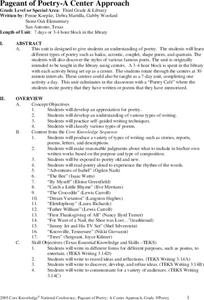Core Knowledge Foundation
A “Whole” Lot of Fraction Fun!
Young mathematicians are introduced to fractions in a unit that helps them to understand parts of a whole.
Mathematics Assessment Project
Designing 3d Products: Candy Cartons
Wouldn't it be great to work in a candy factory? Learners get their chance as they first design a carton for a candy that meets certain requirements. They then examine and analyze nets and explanations in sample student responses.
Curated OER
Sing a Tale
This activity allows students to explore the elements of traditional folktales in folk music.
Curated OER
Animal skeletal design-reduction relief prints
Sixth graders compare and contrast various forms of artistic expression associated with specific groups of people, geographic regions, or time periods, specifically, art of Australia, and create art works using procedures borrowed from...
Curated OER
Fantasy Creature
Students, in groups, create three-dimensional sculptures from found objects. They paint their sculptures and write essays that reflect on the collaborative creative project.
Curated OER
Miriam Schapiro Action Figures Collage
Students create a background with a marbling technique. They plan and create a figure from assorted papers, mixing solids and patterns. Students glue the figure to the background, and embellish negative space with glitter.
Curated OER
Working Together to Improve Our Community
Students from the fourth grade research a solution to a community problem and converse with eighth graders via email. Eighth graders study the political process and work with the fourth graders to present information to the public to...
Curated OER
The Jungle and Readers Response
Students identify the conditions that many workers faced during the Industrial Revolution. They work collaboratively to explain and identify key elements from Chapter 14 of The Jungle.
Curated OER
Commas, Commas Everywhere
Students explore all the uses of commas by finding sentences using commas and describing how they are used by comparing the sentences to the rules for utilizing commas. They create a poster with five rules of commas and examples for each...
Curated OER
A Passport to WWII and the Holocaust
Students explore the Holocaust. In this interdisciplinary lesson, students research Hitler's rise to power, the terror of concentration camps, and World War II. Students read The Diary of Anne Frank , listen to a Holocaust survivor, and...
Curated OER
The Preterite vs. the Imperfect
Students write their own original studenT story in the past in Spanish using the imperfect and the preterite after watching the teacher present the provided Power Point presentation on the differences in the uses of the two.
Curated OER
Land Ho! Cole Vs. Van Gogh
Students compare and contrast the landscape works of Thomas Cole and Vincent Van Gogh. In this landscapes lesson, students understand vocabulary related to artworks. Students compare and contrast the artists work through a Venn diagram....
Curated OER
ABC Bookmaking Builds Vocabulary In the Content Areas
Students create an ABC book using vocabulary words from content areas. They use each word in context and create an illustration for each word to further demonstrate their knowledge of its meaning.
Curated OER
A Center Approach to Poetry
Students experience the different types of poetry in order to classify them. In this poetry lesson, students discover the multiple types of poetry while reading in the library. Ultimately, the students create their own poetry and share...
Curated OER
The Coffee House
Students study and write poetry. In this poetry project, students read, analyze, and produce poetry. Students examine and analyze fifteen poems and at the culmination of the unit, perform one of their poems for an audience.
Curated OER
The Mystery of the Missing Hummingbirds
Students record scientific observations in a science journal. In this season lesson, students make observations about each of the seasons and record in their journals. Students record organisms response to seasonal changes...
Curated OER
Europe in the Middle Ages
Students focus on the development of European civilization during the Middle Ages in Europe through this series of lessons. They develop an awareness for time and place, explain the complex nature of cultures, and real and mythical...
Curated OER
Let's Trade! The Prince and the Pauper
Students read and analyze the novel, The Prince and the Pauper. They examine character development, discuss opinions using text, and develop and present a slide show demonstrating the development of a character from the beginning to the...
Curated OER
The Editorial Revisited
Students identify different types of editorials. They explain, using a graphic organizer, the elements that make an editorial powerful. They offer elements they came up with and the examples and list them on the board.
Curated OER
The Dangers of Illiteracy
Students consider a fictional situation in which literacy could spell the difference between life and death. They apply their knowledge of how reading empowers people by creating a literacy program that addresses the special needs of a...
Curated OER
It's Not Just Story Time... It's Learning Time!
Students look at picture books and describe the story elements. In this picture book lesson, students retell a story and begin to understand the story elements of plot, setting, and characters. Students complete graphic organizers to...
Core Knowledge Foundation
Gulliver's Travels
Students read and analyze the book, Gulliver's Travels. They develop a reading folder, identify the main story elements, compare/contrast Gulliver's adventures in Lilliput and Brobdingnag, and write a paragraph about the main characters.
Curated OER
Still Life
High schoolers compose a three-dimensional still life composition in a shoe box, sketch portions of their work and then design a painting based on the finished box. They complete and critique their paintings.
Curated OER
Combining Direct and Indirect Object Pronouns
Students combine direct and indirect pronouns in this lesson. They practice with rewriting sentences when a direct and indirect object is present. They create a story using PowerPoint with their new sentences.























